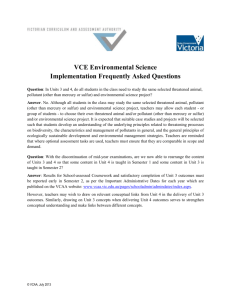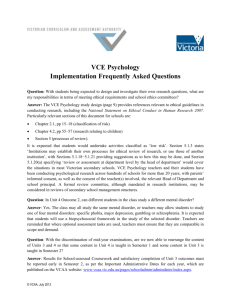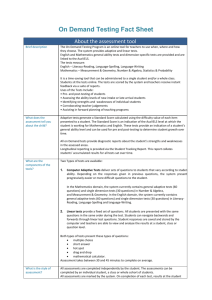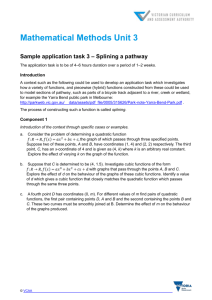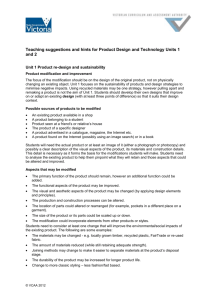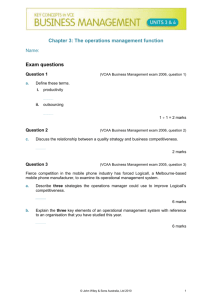Example 2 (VCAA 1988 Question 7, 1 mark)
advertisement
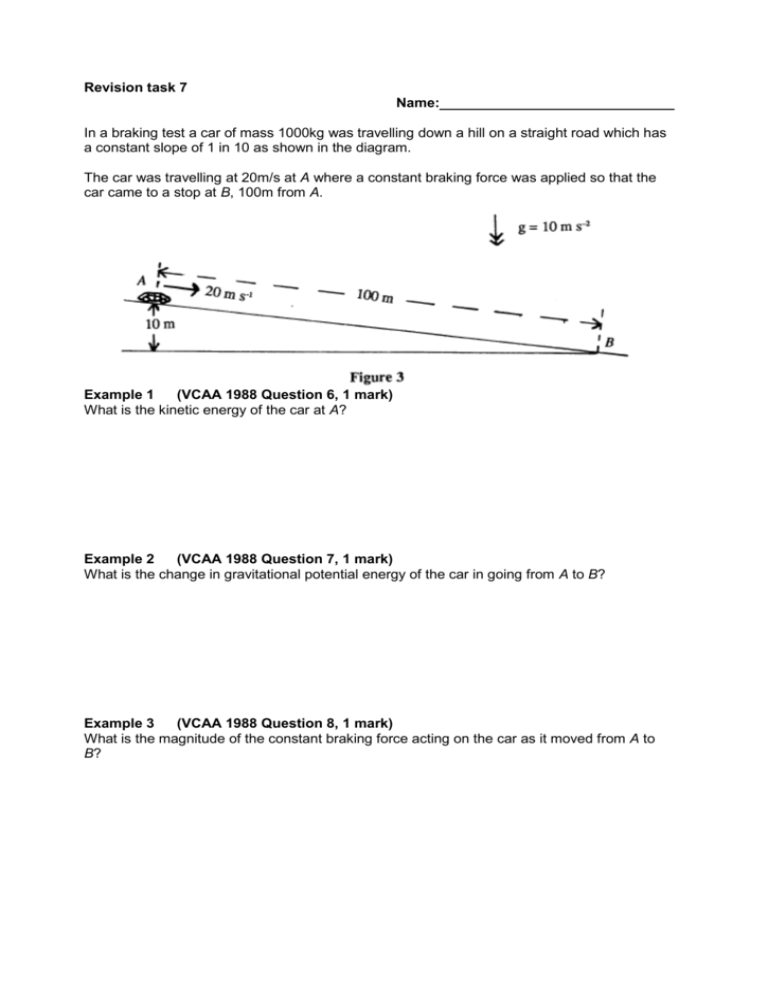
Revision task 7 Name: In a braking test a car of mass 1000kg was travelling down a hill on a straight road which has a constant slope of 1 in 10 as shown in the diagram. The car was travelling at 20m/s at A where a constant braking force was applied so that the car came to a stop at B, 100m from A. Example 1 (VCAA 1988 Question 6, 1 mark) What is the kinetic energy of the car at A? Example 2 (VCAA 1988 Question 7, 1 mark) What is the change in gravitational potential energy of the car in going from A to B? Example 3 (VCAA 1988 Question 8, 1 mark) What is the magnitude of the constant braking force acting on the car as it moved from A to B? A spring behaves so that the restoring force it exerts is related to the compression by the relationship F = 200 x, where F is the magnitude of the restoring force (in N) and x is the compression (in m). A body of mass 0.50 kg travelling at 2.0 m s-1 approaches the spring which is fixed to a wall as shown. Friction can be neglected. The body comes to rest instantaneously at a time T1, when the spring is compressed by a total amount x1. It then rebounds. Example 4 (VCAA 1977 Question 21, 1 mark) Calculate the value of x1. Example 5 (VCAA 1977 Question 22, 1 mark) Which of the graphs below best represents the kinetic energy of the body as a function of the compression, x1, of the spring? Example 6 (VCAA 1977 Question 23, 1 mark) At time t1, when the mass has come to rest, what has happened to the original momentum of the mass? A. It is now stored in the spring. B. It has been transferred to the earth. C. It has been dissipated as sound and heat. D. It has been lost because the collision was not perfectly elastic. Example 7 (VCAA 1977 Question 24, 1 mark) What is the magnitude of the momentum of the mass when the spring has been compressed by and amount ½x1? Kathy is riding her bike. She starts from rest and pedals on horizontal ground so as to provide a constant driving force of 75 N on the bike. Kathy and the bike have a combined mass of 80.0 kg. After travelling a distance of 500 m, she is travelling at a constant speed of 15.0 ms-1. The total force opposing the motion is not constant and varies as her speed changes. The figure below shows how the total force opposing the motion of Kathy and the bike varies as a function of the distance travelled. Example 8 (VCAA 1997 Question 1, 1 mark) What was the resultant force acting on Kathy and the bike after she had travelled a distance of 550 m? Example 9 (VCAA 1997 Question 2, 1 mark) What was Kathy’s acceleration as she passed the 300 m point? Show your working. Jessica moves down a water slide of vertical height 6.0 m into a swimming pool as shown below. Jessica starts from rest at Q and you may assume that friction and air resistance are negligible. Example 10 (VCAA 1996 Question 1, 1 mark) Calculate the speed of Jessica at the point S. Example 11 (VCAA 1996 Question 2, 1 mark) On the figure sketch and label the individual forces on Jessica at the point R. Now consider the forces on Jessica at point S. Example 12 (VCAA 1996 Question 3, 1 mark) Which one of the arrows (A - F) below best represents the net force on Jessica at point S? Shooting for a basket, a basketballer releases the ball at 450 above the horizontal when the centre of the ball is 3.0m above the ground. It passes cleanly through the basket which is 3.0m above the ground, and 9.0 m from the basketballer's hand. The acceleration due to gravity can be taken as 10 ms-2. Air resistance can be neglected. The situation is shown below. The ball takes 1.34 s from leaving the player's hand to passing through the ring. Example 13 (VCAA 1995 Question 1, 1 mark) What is the horizontal component of the velocity of the ball as it leaves the player's hand? Example 14 (VCAA 1995 Question 2, 1 mark) What is the magnitude of the velocity of the ball as it leaves the player's hand? Example 15 (VCAA 1995 Question 3, 1 mark) What was the highest point above the ground, reached by the centre of the ball? Show your working. Eddie Irvine and his Formula 1 racing car are taking a corner in the Australian Grand Prix. A camera views the racing car head-on at point X on the bend where it is travelling at constant speed. At this point the radius of curvature is 36.0 m. The total mass of car and driver is 800 kg. Example 16 (VCAA 1999 Question 13, 1 mark) On Figure 7, showing the camera’s view of the racing car, draw an arrow to represent the direction of the net force acting on the racing car at this instant. The figure shows a cyclist with the bicycle wheels in contact with the road surface. The cyclist is about to start, accelerating forwards. Example 17 (VCAA 2002 Question 14, 1 mark) Explain, with the aid of a clear force diagram, how the rotation of the wheels results in the cyclist accelerating forwards. A traffic investigator comes upon the scene of an accident and observes a damaged car at rest. A skid mark leading to the car is 50 m long. The investigator is aware that the mass of this car is 1.0 tonne and that the frictional braking force when skidding was approximately 10 000 N. From this evidence she is able to estimate the speed of the car immediately before the driver applied the brakes. Example 18 (VCAA 2001 Question 14, 1 mark) Assuming a constant braking force, calculate the speed of the car just before the driver applied the brakes. At a car show a driver plans to drive up a 20° ramp and jump her car across a row of parked cars, as shown below. She plans to be travelling at 30 ms-1 at the instant the car leaves the ramp. The landing ramp on the opposite side of the gap is at the same height as the launching ramp. Example 19 (VCAA 2001 Question 15, 1 mark) Calculate the maximum gap distance that the car can safely jump. (Model the car as a point.) The road safety slogan for 2002 is ‘Stay alive – wipe off five’. This is to encourage drivers to travel more slowly, so as to reduce the stopping distance when reacting to a hazard. For a car travelling at 60 km h-1 the speed–time graph for a driver with a reaction time of 0.2 s and then braking to a stop with a constant braking force is shown below. Example 20 (VCAA 2002 Question 15, 1 mark) On the graph, draw the speed–time graph for the same car and driver travelling at 65 kmh-1 reacting to a hazard and then braking to a stop with the same constant braking force. Example 21 (VCAA 2002 Question 16, 1 mark) With reference to the graph, describe how you could determine the difference between the stopping distances at 65 km h-1 and 60 km h-1.

